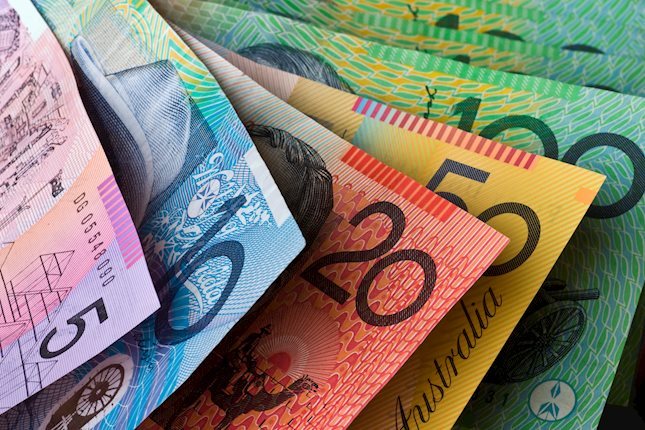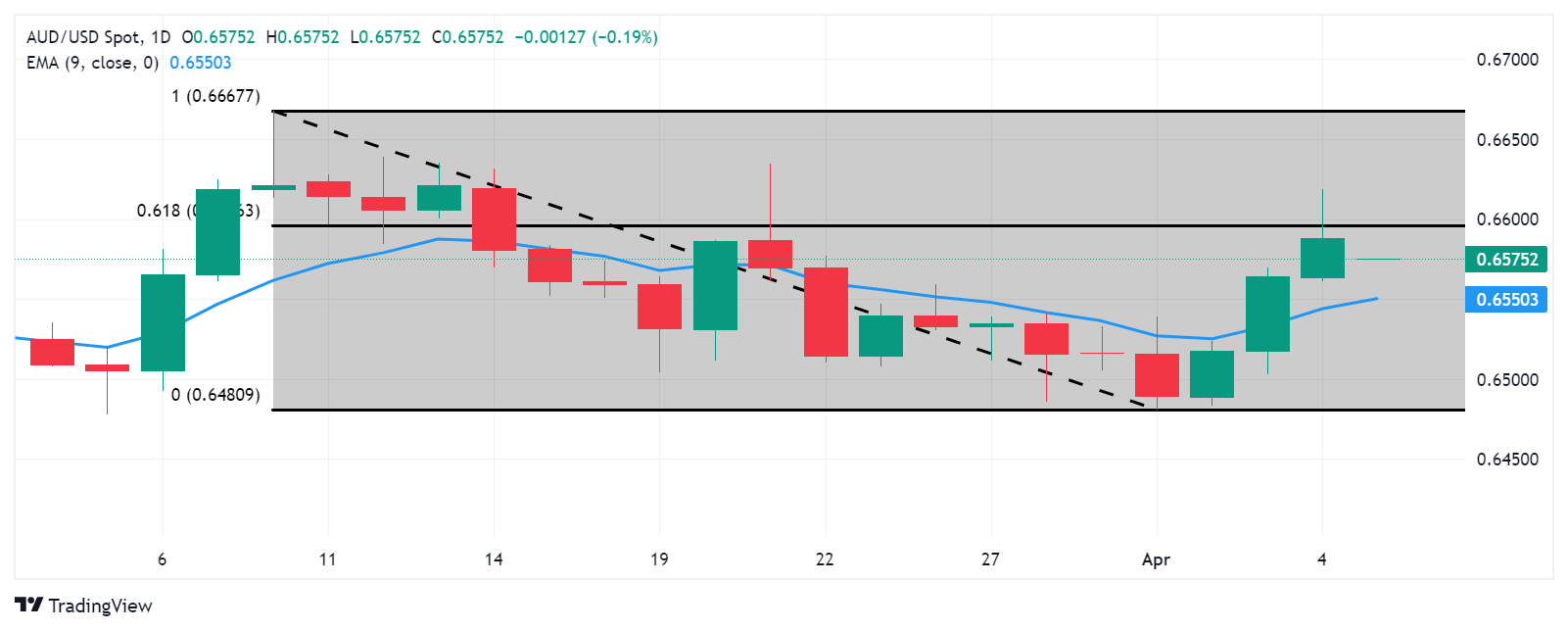- Australian Dollar depreciates after the release of mixed domestic economic numbers.
- Australia’s Trade Balance fell to 7,280M MoM in March from February’s reading of 10,058M.
- US Dollar could lose ground if Nonfarm Payrolls decline as expected.
The Australian Dollar (AUD) snaps its three-day winning streak following the release of unchanged Final Retail Sales and downbeat Trade Balance data from Australia on Friday. However, the US Dollar (USD) faced downward pressure due to softer labor market data from the United States (US) on Thursday, supporting the AUD/USD pair.
Australia’s Trade Surplus (Month-over-Month) narrowed to 7,280 million in March, falling short of the expected 10,400 million and February’s reading of 10,058 million, according to data published by the Australian Bureau of Statistics. Australia's Exports decreased by 2.2% month-over-month, contrasting with the previous increase of 1.6%. Meanwhile, the nation’s Imports grew by 4.8%, compared to 1.3% prior.
The US Dollar Index (DXY) consolidates with a negative sentiment, reflecting the drop in US Treasury yields, possibly influenced by neutral comments from several Federal Reserve officials. However, the US Dollar might have attracted investors amid market caution due to escalating geopolitical tensions following Israel’s attack on Iran's embassy in Syria. Traders await US labor market data including Average Hourly Earnings and Nonfarm Payrolls scheduled to be released on Friday.
Daily Digest Market Movers: Australian Dollar depreciates on mixed economic figures
- Australia's Final Retail Sales were unchanged at 0.3% in February, which is in line with expectations.
- Australian Judo Bank Services PMI improved to 54.4 in March from 53.5 in February. Judo Bank Composite PMI increased to 53.3 from the previous reading of 52.4.
- Australia’s Building Permits (MoM) fell by 1.9% in February against the expected increase of 3.3% and the previous decline of 2.5%. In comparison, there is an increase of 5.2% YoY, compared to the previous increase of 4.8%.
- RBA March minutes showed that the board did not contemplate the option of raising interest rates. They unanimously agreed that it was challenging to definitively predict future changes in the cash rate. While the economic outlook remained uncertain, the risks appeared to be generally balanced. The board acknowledged that it would require "some time" before they could express confidence in inflation returning to the target level.
- Federal Reserve (Fed) Bank of Richmond President Thomas Barkin remarked that disinflation is expected to persist, although the pace of this trend remains uncertain. He stated, "I am open to rate cuts once it is clear that progress on inflation will be sustained and apply more broadly in the economy."
- Loretta Mester, President of the Federal Reserve Bank of Cleveland, suggested on Thursday that she would be open to reducing the pace of securities runoff from the Fed’s balance sheet soon. She also anticipated to be in a position to lower the fed funds rate later this year.”
- Fed Chair Jerome Powell reaffirmed the US central bank's preparedness to implement rate cuts, emphasizing a data-dependent approach. Atlanta Fed President Raphael Bostic's remarks advocating for a rate cut in the final quarter of 2024.
- Adriana Kugler, a member of the Fed Board of Governors, highlighted that the ongoing disinflationary trend would necessitate rate reductions, with expectations of at least three cuts by the last quarter of 2024.
- US Initial Jobless Claims for the week ended March 29 rose by 9,000 to 221,000 from the previous week’s reading of 212,000, below the market consensus of 214,000.
- US Challenger Job Cuts posted 90.309K for March against the previous reading of 84.638K.
- US ADP Employment Change rose by 184K in March, compared to the 155K increase in February, above the market consensus of 148K.
- US ISM Services PMI eased to 51.4 in March from 52.6 in February, weaker than the expectation of 52.7. US ISM Manufacturing PMI climbed to 50.3 in March from February's 47.8, surpassing expectations of 48.4.
Technical Analysis: Australian Dollar maintains position below the psychological mark of 0.6600
The Australian Dollar trades around 0.6570 on Friday. The immediate resistance region is observed around the 61.8% Fibonacci retracement level of 0.6596, coinciding with the psychological level of 0.6600. A breakthrough above this level could potentially propel the AUD/USD pair to explore the area around the major level of 0.6650 and March’s high of 0.6667. On the downside, key support is identified around the nine-day Exponential Moving Average (EMA) of 0.6552 and the major support level of 0.6550. A breach below the latter could exert downward pressure on the AUD/USD pair, potentially leading it toward the psychological level of 0.6500.
AUD/USD: Daily Chart
(This story was corrected on April 05 at 03:15 GMT to say, in the second bullet and paragraph, "February’s reading of 10,058M" instead 11,027M.)
Australian Dollar price today
The table below shows the percentage change of Australian Dollar (AUD) against listed major currencies today. Australian Dollar was the weakest against the Japanese Yen.
| USD | EUR | GBP | CAD | AUD | JPY | NZD | CHF | |
| USD | 0.08% | 0.16% | 0.20% | 0.23% | -0.05% | 0.31% | 0.14% | |
| EUR | -0.09% | 0.09% | 0.11% | 0.15% | -0.13% | 0.23% | 0.06% | |
| GBP | -0.17% | -0.09% | 0.03% | 0.07% | -0.22% | 0.14% | -0.03% | |
| CAD | -0.20% | -0.12% | -0.03% | 0.03% | -0.25% | 0.12% | -0.05% | |
| AUD | -0.24% | -0.16% | -0.07% | -0.03% | -0.29% | 0.07% | -0.08% | |
| JPY | 0.05% | 0.14% | 0.21% | 0.23% | 0.28% | 0.36% | 0.19% | |
| NZD | -0.32% | -0.22% | -0.14% | -0.11% | -0.07% | -0.36% | -0.18% | |
| CHF | -0.17% | -0.08% | 0.00% | 0.03% | 0.08% | -0.20% | 0.15% |
The heat map shows percentage changes of major currencies against each other. The base currency is picked from the left column, while the quote currency is picked from the top row. For example, if you pick the Euro from the left column and move along the horizontal line to the Japanese Yen, the percentage change displayed in the box will represent EUR (base)/JPY (quote).
Australian Dollar FAQs
One of the most significant factors for the Australian Dollar (AUD) is the level of interest rates set by the Reserve Bank of Australia (RBA). Because Australia is a resource-rich country another key driver is the price of its biggest export, Iron Ore. The health of the Chinese economy, its largest trading partner, is a factor, as well as inflation in Australia, its growth rate and Trade Balance. Market sentiment – whether investors are taking on more risky assets (risk-on) or seeking safe-havens (risk-off) – is also a factor, with risk-on positive for AUD.
The Reserve Bank of Australia (RBA) influences the Australian Dollar (AUD) by setting the level of interest rates that Australian banks can lend to each other. This influences the level of interest rates in the economy as a whole. The main goal of the RBA is to maintain a stable inflation rate of 2-3% by adjusting interest rates up or down. Relatively high interest rates compared to other major central banks support the AUD, and the opposite for relatively low. The RBA can also use quantitative easing and tightening to influence credit conditions, with the former AUD-negative and the latter AUD-positive.
China is Australia’s largest trading partner so the health of the Chinese economy is a major influence on the value of the Australian Dollar (AUD). When the Chinese economy is doing well it purchases more raw materials, goods and services from Australia, lifting demand for the AUD, and pushing up its value. The opposite is the case when the Chinese economy is not growing as fast as expected. Positive or negative surprises in Chinese growth data, therefore, often have a direct impact on the Australian Dollar and its pairs.
Iron Ore is Australia’s largest export, accounting for $118 billion a year according to data from 2021, with China as its primary destination. The price of Iron Ore, therefore, can be a driver of the Australian Dollar. Generally, if the price of Iron Ore rises, AUD also goes up, as aggregate demand for the currency increases. The opposite is the case if the price of Iron Ore falls. Higher Iron Ore prices also tend to result in a greater likelihood of a positive Trade Balance for Australia, which is also positive of the AUD.
The Trade Balance, which is the difference between what a country earns from its exports versus what it pays for its imports, is another factor that can influence the value of the Australian Dollar. If Australia produces highly sought after exports, then its currency will gain in value purely from the surplus demand created from foreign buyers seeking to purchase its exports versus what it spends to purchase imports. Therefore, a positive net Trade Balance strengthens the AUD, with the opposite effect if the Trade Balance is negative.
Information on these pages contains forward-looking statements that involve risks and uncertainties. Markets and instruments profiled on this page are for informational purposes only and should not in any way come across as a recommendation to buy or sell in these assets. You should do your own thorough research before making any investment decisions. FXStreet does not in any way guarantee that this information is free from mistakes, errors, or material misstatements. It also does not guarantee that this information is of a timely nature. Investing in Open Markets involves a great deal of risk, including the loss of all or a portion of your investment, as well as emotional distress. All risks, losses and costs associated with investing, including total loss of principal, are your responsibility. The views and opinions expressed in this article are those of the authors and do not necessarily reflect the official policy or position of FXStreet nor its advertisers. The author will not be held responsible for information that is found at the end of links posted on this page.
If not otherwise explicitly mentioned in the body of the article, at the time of writing, the author has no position in any stock mentioned in this article and no business relationship with any company mentioned. The author has not received compensation for writing this article, other than from FXStreet.
FXStreet and the author do not provide personalized recommendations. The author makes no representations as to the accuracy, completeness, or suitability of this information. FXStreet and the author will not be liable for any errors, omissions or any losses, injuries or damages arising from this information and its display or use. Errors and omissions excepted.
The author and FXStreet are not registered investment advisors and nothing in this article is intended to be investment advice.
Recommended content
Editors’ Picks

AUD/USD continues soft as markets digest employment data
The AUD/USD declined by 0.34% to 0.6470 in Thursday's session, extending its decline to a fresh three-month low of 0.6460. The US Dollar is easing after mixed data, while weak Australian employment data has reduced inflationary concerns, which might change the outlook of the Reserve Bank of Australia.

USD/JPY jumps above 156.50 after Japanese GDP, eyes on US Retail Sales data
The USD/JPY pair extends the rally to around 156.60, the highest level since July 23 during the early Asian session on Friday. The upward movement of the pair is bolstered by the firmer US Dollar broadly. Traders brace for the US October Retail Sales, which is due later on Friday.

Gold falls as Powell signals Fed's patience on lowering rates
Gold recovers some ground on Thursday yet remains trading below its opening price for the fifth consecutive day, undermined by the Greenback’s advance for its own fifth consecutive day. A slightly hot inflation report in the US and solid jobs data sponsored XAU/USD’s leg down toward the 100-day SMA.

Bitcoin Price Forecast: BTC eyes $100K, what are the key factors to watch out for?
Bitcoin trades below $90K in the early Asian session on Friday as investors realized nearly $8 billion in profits in the past two days. Despite the profit-taking, Bitwise CIO Matt Hougan suggested that BTC could be ready for the $100K level, fueled by increased stablecoin supply and potential government investment.

Trump vs CPI
US CPI for October was exactly in line with expectations. The headline rate of CPI rose to 2.6% YoY from 2.4% YoY in September. The core rate remained steady at 3.3%. The detail of the report shows that the shelter index rose by 0.4% on the month, which accounted for 50% of the increase in all items on a monthly basis.

Best Forex Brokers with Low Spreads
VERIFIED Low spreads are crucial for reducing trading costs. Explore top Forex brokers offering competitive spreads and high leverage. Compare options for EUR/USD, GBP/USD, USD/JPY, and Gold.
